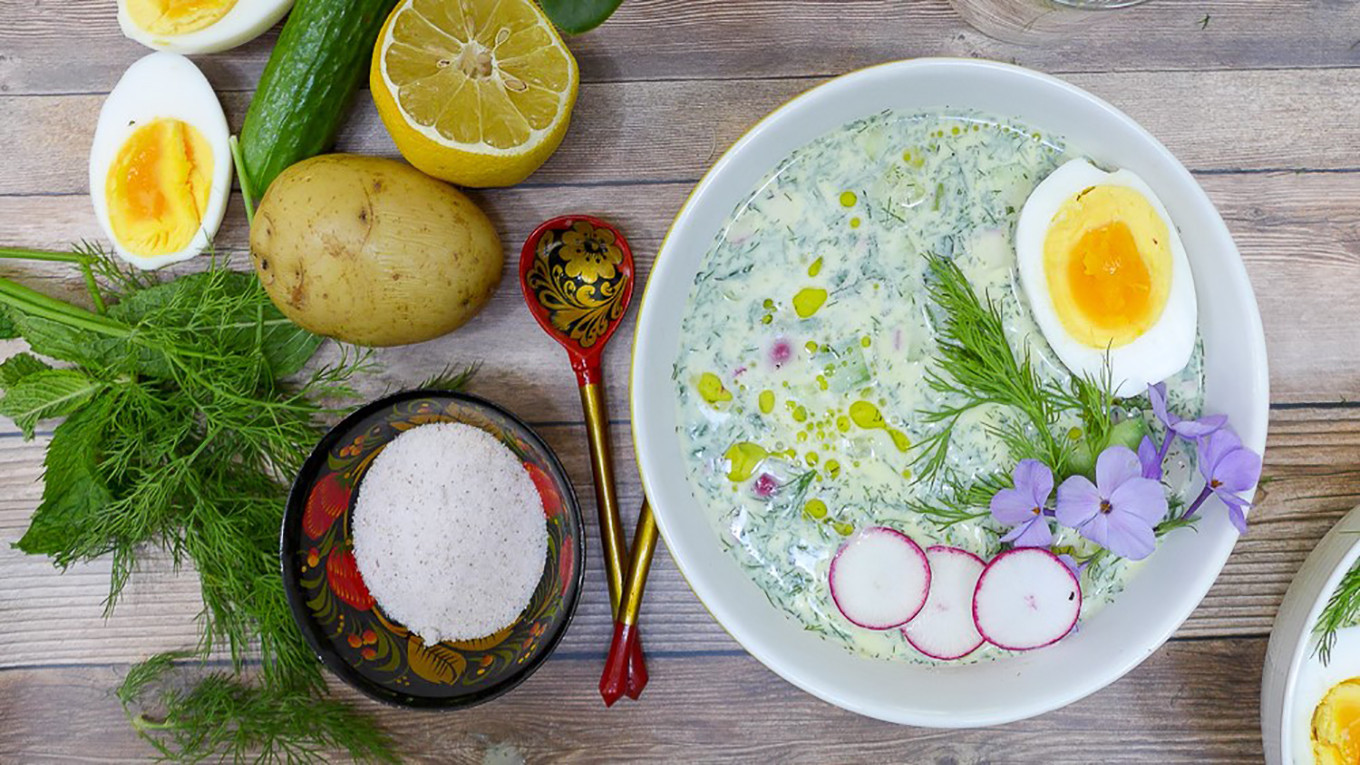
Late spring and early summer are all about change and transition. Glass windows are swapped out for screens, kids flee school for summer holidays, and wool sweaters and coats take their annual trip to the dry cleaner.
In Russia, for many the summer months mean the slower, simpler life of the dacha, where there are fewer modern conveniences and lots more fresh produce. “Dacha Cuisine” is different from other Russian food: the recipes are simpler and put the ingredients front and center. Cucumbers, radishes, and potatoes may seem like boring workaday ingredients in complex dishes, but when you pick them and eat them just a few hours later, they become superstars.
In my kitchen, when summer stops flirting and settles in for good, the Instapot is banished from the countertop and the Vitamix takes its place. Hot soups and stews make way for cool containers of gazpacho, cucumber and yogurt, and vichyssoise, along with a regular appearance of Russia’s own signature cold soup: okroshka.
This is dacha food at its best: a few ingredients, ideally freshly picked, and very simple instructions. What could be simpler than “crushing” or “kroshit’,” from which the soup gets its name? I sometimes feel that making okroshka is more a knife skills exercise than a recipe, but it doesn’t stop me from consuming it all summer long!
Okroshka combines hard-boiled eggs, cucumbers, radishes, scallions, ham, and potatoes with chilled liquid. There are two types of liquid: kvass, the fermented bread drink, and kefir. I prefer the kefir, not because I’m not a kvass lover — I am — but kefir combines so well with the egg yolks in this recipe, producing a creamy base that carries a welcome kick of horseradish and mustard. Few dishes are more refreshing on a hot day.
My recipe for okroshka follows the classics with a few tweaks. I once tried okroshka in Canada made with buttermilk, and the tang paired beautifully with the umami of the hard-boiled eggs and the saltiness of the ham. The only problem is that okroshka needs a little bit of fizz, so I now split the difference between kefir and buttermilk. For those who like more fizz, the addition of a bit of kvass or fizzy mineral water is always possible.
Try not to overcook the hard-boiled eggs. Yolks that are “jammy” blend more easily with the liquid, thickening it admirably without the chalky texture of an overgone yolk.
Vegetarians can swap out the ham and eggs for other ingredients, and there are endless ways to get creative with okroshka. I include four of my favorites below.
Enjoy the taste of summer!
Ingredients
- 6 eggs
- 150 grams of smoked ham, cubed
- 3 medium sized potatoes, boiled in their skin, then chilled, peeled, and cubed
- Juice of one lemon
- 1 large English cucumber or 5 smaller “Persian” or pickling cucumbers, cubed
- 10-12 red radishes, cubed
- 6 scallions, diced very thinly
- 1 large bunch of dill
- 5 sprigs of mint
- 2 Tbsp Dijon mustard
- 1 Tbsp prepared horseradish
- 1 tsp chili pepper or a milder paprika
- Salt and freshly ground black pepper to taste
- 750 ml kefir
- 550 ml buttermilk
- 2 Tbsp olive oil
Instructions
Prepare the hard-boiled eggs
- Place the eggs in a pan of cold salted water.
- Bring to a boil, then remove immediately from heat. Cover and let sit for 10 minutes.
- As soon as the timer goes off, plunge the eggs into a bowl of ice water.
- Peel 5 of the 6 eggs and separate the yolks from the whites. Set the yolks aside and slice the whites into small, bite-sized cubes.
Prepare the ham and vegetables
- Slice and dice the cucumber, boiled potato, radishes, scallions, and ham into similarly-sized bite-sized pieces.
- Chop half of the dill and mint finely and add.
- Cover and chill until you are ready to serve.
Prepare the liquids
- Mash the egg yolks with the back of a fork or in a food processor fitted with a steel blade.
- Whisk or add in the mustard and horseradish and red pepper. Process or whisk until smooth.
- Add the kefir, lemon juice, and buttermilk, and the remaining dill and mint and most of the red pepper. Taste and adjust with salt and pepper. Process or whisk to combine.
- Chill for 2 hours.
Assemble the soup
- Spoon a cupful of the vegetable and ham mixture into a shallow soup bowl.
- Pour enough liquid to cover the solids. Garnish with the remaining hard-boiled egg and more fresh herbs, and a slick of olive oil.
- Serve with a grinding of fresh pepper and a dusting of the remaining red pepper.
Like all Russian soups, Okroshka varies wildly according to region, time of year, and what is growing in the cook’s garden or languishing in her larder. Feel free to play around with the ingredients: many cooks swear by a combination of kefir and sparkling water for a base, while others use the traditional kvass with a dollop of sour cream or creme fraiche.
Here are some riffs on okroshka’s solid ingredients that I swap out throughout the summer:
Baltic Okroshka: Substitute cooked shrimp or cubed smoked salmon for the ham, and add watercress, lovage, and chives to the cucumbers and radishes. Add lots more dill and another squeeze of lemon juice.
Greek Okroshka: Crumble Feta cheese on top of the soup and double the olive oil slick.
Fruit Okroshka: Skeptics may call this a deconstructed smoothie, but substituting berries, cherries, and peaches for the vegetables is a winner. Swap in tarragon for the dill and drizzle with a little bit of honey.
Mediterranean Okroshka: Up the temperature with chorizo sausage instead of ham, roasted peppers for radishes and asparagus in season. Garnish with seeded fresh tomatoes and basil.






